LG Electronics USA VS985 GSM/WCDMA/CDMA/LTE PHONE + BLUETOOTH & DTS/UNII a/b/g/n/ac + NFC User Manual Manual 3
LG Electronics MobileComm USA, Inc. GSM/WCDMA/CDMA/LTE PHONE + BLUETOOTH & DTS/UNII a/b/g/n/ac + NFC Manual 3
Contents
Manual 3

199
Safety
limit set by the FCC is 1.6 W/kg. Tests for SAR are conducted using
standard operating positions specified by the FCC with the phone
transmitting at its highest certified power level in all tested frequency
bands. Although SAR is determined at the highest certified power level, the
actual SAR level of the phone while operating can be well below the
maximum value. Because the phone is designed to operate at multiple
power levels to use only the power required to reach the network, in
general, the closer you are to a wireless base station antenna, the lower
the power output.
Before a phone model is available for sale to the public, it must be tested
and certified to the FCC that it does not exceed the limit established by the
government-adopted requirement for safe exposure. The tests are
performed in positions and locations (e.g., at the ear and worn on the body)
as required by the FCC for each model.
The highest SAR value for this model phone when tested for use at the ear
is X.XX W/kg and when worn on the body, as described in this user guide,
is X.XX W/kg (body-worn measurements differ among phone models,
depending upon available accessories and FCC requirements). While there
may be differences between SAR levels of various phones and at various
positions, they all meet the government requirement for safe exposure.
The FCC has granted an Equipment Authorization for this model phone with
all reported SAR levels evaluated as in compliance with the FCC RF
emission guidelines. SAR information on this model phone is on file with
the FCC and can be found under the Display Grant section of http://www.
fcc.gov/oet/fccid after searching on FCC ID XXX. Additional information on
Specific Absorption Rates (SAR) can be found on the Cellular
Telecommunications Industry Association (CTIA) website at http://www.
ctia.org/.
* In the United States and Canada, the SAR limit for mobile phones used
by the public is 1.6 watts/kg (W/kg) averaged over one gram of tissue.
The standard incorporates a substantial margin of safety to give additional
protection for the public and to account for any variations in
measurements.
0.56
0.99
FCC ID ZNFVS985

200 Safety
FCC Hearing-Aid Compatibility (HAC) Regulations
for Wireless Devices
On July 10, 2003, the U.S. Federal Communications Commission (FCC)
Report and Order in WT Docket 01-309 modified the exception of wireless
phones under the Hearing Aid Compatibility Act of 1988 (HAC Act) to
require digital wireless phones be compatible with hearing-aids. The intent
of the HAC Act is to ensure reasonable access to telecommunications
services for persons with hearing disabilities.
While some wireless phones are used near some hearing devices (hearing
aids and cochlear implants), users may detect a buzzing, humming, or
whining noise. Some hearing devices are more immune than others to this
interference noise, and phones also vary in the amount of interference they
generate.
The wireless telephone industry has developed a rating system for wireless
phones, to assist hearing device users to find phones that may be
compatible with their hearing devices. Not all phones have been rated.
Phones that are rated have the rating on their box or a label located on the
box.
The ratings are not guarantees. Results will vary depending on the user's
hearing device and hearing loss. If your hearing device happens to be
vulnerable to interference, you may not be able to use a rated phone
successfully. Trying out the phone with your hearing device is the best way
to evaluate it for your personal needs.
M-Ratings: Phones rated M3 or M4 meet FCC requirements and are likely
to generate less interference to hearing devices than phones that are not
labeled. M4 is the better/higher of the two ratings.
T-Ratings: Phones rated T3 or T4 meet FCC requirements and are likely to
generate less interference to hearing devices than phones that are not
labeled. T4 is the better/ higher of the two ratings.
Hearing devices may also be rated. Your hearing device manufacturer or
hearing health professional may help you find this rating. Higher ratings
mean that the hearing device is relatively immune to interference noise.
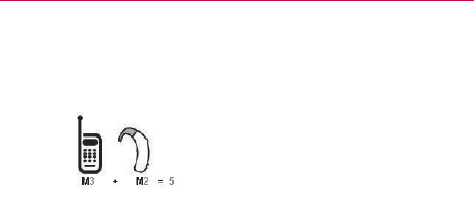
201
Safety
The hearing aid and wireless phone rating values are then added together.
A sum of 5 is considered acceptable for normal use. A sum of 6 is
considered for best use.
In the above example, if a hearing aid meets the M2 level rating and the
wireless phone meets the M3 level rating, the sum of the two values equal
M5. This should provide the hearing aid user with “normal usage” while
using their hearing aid with the particular wireless phone. “Normal usage”
in this context is defined as a signal quality that’s acceptable for normal
operation.
The M mark is intended to be synonymous with the U mark. The T mark is
intended to be synonymous with the UT mark. The M and T marks are
recommended by the Alliance for Telecommunications Industries Solutions
(ATIS). The U and UT marks are referenced in Section 20.19 of the FCC
Rules. The HAC rating and measurement procedure are described in the
American National Standards Institute (ANSI) C63.19 standard.
When you're talking over the cell phone, it's recommended you'd turn the
BT (Bluetooth) mode off for HAC.
This phone has been tested and rated for use with hearing aids for some of
the wireless technologies that it uses. However, there may be some newer
wireless technologies used in this phone that have not been tested yet for
use with hearing aids. It is important to try the different features of this
phone thoroughly and in different locations, using your hearing aid or
cochlear implant, to determine if you hear any interfering noise. Consult
your service provider or the manufacturer of this phone for information on
hearing aid compatibility. If you have questions about return or exchange
policies, consult your service provider or phone retailer.
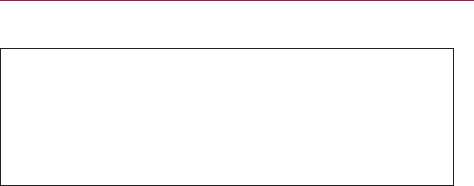
202 Safety
For information about hearing aids and digital wireless phones
Wireless Phones and Hearing Aid Accessibility
http://www.accesswireless.org/hearingaid/
FCC Hearing Aid Compatibility and Volume Control
http://www.fcc.gov/cgb/consumerfacts/hac_wireless.html
Caution:
Avoid potential hearing loss.
Prolonged exposure to loud sounds (including music) is the most common
cause of preventable hearing loss. Some scientific research suggests that
using portable audio devices, such as portable music players and cellular
telephones, at high volume settings for long durations may lead to
permanent noise-induced hearing loss. This includes the use of
headphones (including headsets, earbuds and Bluetooth® or other wireless
devices). Exposure to very loud sound has also been associated in some
studies with tinnitus (a ringing in the ear), hypersensitivity to sound and
distorted hearing. Individual susceptibility to noise-induced hearing loss and
other potential hearing problems varies.
The amount of sound produced by a portable audio device varies depending
on the nature of the sound, the device, the device settings and the
headphones. You should follow some commonsense recommendations
when using any portable audio device:
s Set the volume in a quiet environment and select the lowest volume at
which you can hear adequately.
s When using headphones, turn the volume down if you cannot hear the
people speaking near you or if the person sitting next to you can hear
what you are listening to.
s Do not turn the volume up to block out noisy surroundings. If you choose
to listen to your portable device in a noisy environment, use noise-
cancelling headphones to block out background environmental noise.

203
Safety
s Limit the amount of time you listen. As the volume increases, less time is
required before your hearing could be affected.
s Avoid using headphones after exposure to extremely loud noises, such as
concerts, that might cause temporary hearing loss. Temporary hearing
loss might cause unsafe volumes to sound normal.
s Do not listen at any volume that causes you discomfort. If you experience
ringing in your ears, hear muffled speech or experience any temporary
hearing difficulty after listening to your portable audio device, discontinue
use and consult your doctor.
TIA Safety Information
The following is the complete TIA Safety Information for wireless handheld
phones.
Exposure to Radio Frequency Signal
Your wireless handheld portable phone is a low power radio transmitter and
receiver. When ON, it receives and sends out Radio Frequency (RF) signals.
In August, 1996, the Federal Communications Commissions (FCC) adopted
RF exposure guidelines with safety levels for handheld wireless phones.
Those guidelines are consistent with the safety standards previously set by
both U.S. and international standards bodies:
ANSI C95.1 (1992) *
NCRP Report 86 (1986)
ICNIRP (1996)
* American National Standards Institute; National Council on Radiation
Protection and Measurements; International Commission on Non-Ionizing
Radiation Protection
Those standards were based on comprehensive and periodic evaluations of
the relevant scientific literature. For example, over 120 scientists,
engineers, and physicians from universities, government health agencies,
and industry reviewed the available body of research to develop the ANSI
Standard (C95.1).

204 Safety
The design of your phone complies with the FCC guidelines (and those
standards).
Antenna Care
Use only the supplied or an approved replacement antenna. Unauthorized
antennas, modifications, or attachments could damage the phone and may
violate FCC regulations.
Phone Operation
NORMAL POSITION: Hold the phone as you would any other telephone
with the antenna pointed up and over your shoulder.
Tips on Efficient Operation
For your phone to operate most efficiently:
Don’t touch the antenna unnecessarily when the phone is in use. Contact
with the antenna affects call quality and may cause the phone to operate at
a higher power level than otherwise needed.
Electronic Devices
Most modern electronic equipment is shielded from RF signals. However,
certain electronic equipment may not be shielded against the RF signals
from your wireless phone.
Pacemakers
The Health Industry Manufacturers Association recommends that a
minimum separation of six (6) inches be maintained between a handheld
wireless phone and a pacemaker to avoid potential interference with the
pacemaker. These recommendations are consistent with the independent
research by and recommendations of Wireless Technology Research.
Persons with pacemakers:
s Should ALWAYS keep the phone more than six (6) inches from their
pacemaker when the phone is turned ON;
s Should not carry the phone in a breast pocket;
s Should use the ear opposite the pacemaker to minimize the potential for
interference;

205
Safety
s Should turn the phone OFF immediately if there is any reason to suspect
that interference is taking place.
Hearing Aids
Some digital wireless phones may interfere with some hearing aids. In the
event of such interference, you may want to consult your service provider
(or call the customer service line to discuss alternatives).
Other Medical Devices
If you use any other personal medical device, consult the manufacturer of
your device to determine if it is adequately shielded from external RF
energy. Your physician may be able to assist you in obtaining this
information.
Health Care Facilities
Turn your phone OFF in health care facilities when any regulations posted in
these areas instruct you to do so. Hospitals or health care facilities may use
equipment that could be sensitive to external RF energy.
Vehicles
RF signals may affect improperly installed or inadequately shielded
electronic systems in motor vehicles. Check with the manufacturer or its
representative regarding your vehicle. You should also consult the
manufacturer of any equipment that has been added to your vehicle.
Posted Facilities
Turn your phone OFF in any facility where posted notices so require.
Aircraft
FCC regulations prohibit using your phone while in the air. Switch OFF your
phone before boarding an aircraft.
Blasting Areas
To avoid interfering with blasting operations, turn your phone OFF when in
a “blasting area” or in areas posted: “Turn off two-way radio”. Obey all
signs and instructions.

206 Safety
Potentially Explosive Atmosphere
Turn your phone OFF when in any area with a potentially explosive
atmosphere and obey all signs and instructions. Sparks in such areas could
cause an explosion or fire resulting in bodily injury or even death.
Areas with a potentially explosive atmosphere are often, but not always
marked clearly. Potential areas may include: fueling areas (such as gasoline
stations); below deck on boats; fuel or chemical transfer or storage
facilities; vehicles using liquefied petroleum gas (such as propane or
butane); areas where the air contains chemicals or particles (such as grain,
dust, or metal powders); and any other area where you would normally be
advised to turn off your vehicle engine.
For Vehicles Equipped with an Air Bag
An air bag inflates with great force. DO NOT place objects, including either
installed or portable wireless equipment, in the area over the air bag or in
the air bag deployment area. If in-vehicle wireless equipment is improperly
installed and the air bag inflates, serious injury could result.
Safety Information
Please read and observe the following information for safe and proper use
of your phone and to prevent damage.
Caution
Violation of the instructions may cause minor or serious damage
to the product.
s Do not disassemble or open crush, bend or deform, puncture or shred.
s Do not modify or remanufacture, attempt to insert foreign objects into the
battery, immerse or expose to water or other liquids, expose to fire,
explosion or other hazard. Such conditions may present the risk of fire or
explosion.
s Only use the battery with a charging system that has been approved and
qualified with the system per IEEE-Std-1725-2006. Use of an unqualified

207
Safety
and non-LG-approved battery or charger may present a risk of fire,
explosion, leakage, or other hazard.
s Avoid dropping the phone, or exposing the phone to a liquid. If the phone
is dropped, especially on a hard surface, or is exposed to a liquid or
comes into contact with a sharp object take it to a service center for
inspection.
s Improper battery use may result in a fire, explosion or other hazard.
Charger and Adapter Safety
s The charger and adapter are intended for indoor use only.
s Insert the battery charger horizontally into the wall power socket.
s Only use the LG-approved battery charger. Otherwise, you may cause
serious damage to your phone.
s Use the correct adapter for your phone when using the battery pack
charger abroad.
Battery Information and Care
s Always unplug the charger from the wall socket after the phone is fully
charged to save unnecessary power consumption of the charger.
s Please read the manual of the specified charger for the charging method.
s Do not damage the power cord by bending, twisting, or heating. Do not
use the plug if it is loose as it may cause electric shock or fire.
s Do not place any heavy items on the power cord. Do not allow the power
cord to be crimped as it may cause electric shock or fire.
s Unplug the power cord prior to cleaning your phone, and clean the power
plug pin when it’s dirty. When using the power plug, ensure that it’s firmly
connected. If not, it may cause excessive heat or fire. If you put your
phone in a pocket or bag without covering the receptacle of the phone
(power plug pin), metallic articles (such as a coin, paperclip or pen) may
short-circuit the phone. Always cover the receptacle when not in use.

208 Safety
s Recharge the battery after long periods of non-use to maximize battery
life. Battery life will vary due to usage pattern and environmental
conditions.
s Please use only an approved charging accessory to charge your LG
phone. Improper handling of the charging port, as well as the use of an
incompatible charger, may cause damage to your phone and void the
warranty.
s Never store your phone in temperatures less than -4°F or greater than
122°F.
s The charging temperature range is regulated between 32°F (0°C) and
113°F (45°C). Do not charge the battery outside of the recommended
temperature range. Charging outside this range might cause excessive
heat generation, serious battery damage, and deterioration of battery's
characteristics and cycle life.
s Do not use or leave the phone in direct sunlight or in a car heated by
sunshine. The battery may generate excessive heat, smoke, or flame. It
also might cause deterioration of battery’s characteristics or cycle life.
s The embedded battery pack has a protection circuit to avoid dangerous
malfunctions. Do not use your device near places which may generate
more than 100V of static electricity because it could damage the
protection circuit. If the protection circuit is damaged, the battery could
rupture, generate smoke, or catch on fire.
s If skin or clothing is smeared with liquid from the internal battery, wash
with fresh water. It may cause the skin inflammation.
s Please take your phone to an authorized service center immediately if this
occurs.
s Do not handle the phone with wet hands while it is being charged. It may
cause an electric shock or seriously damage your phone.
s The charger and adapter are intended for indoor use only.
s Insert the battery pack charger horizontally into the wall power socket.

209
Safety
s Only use the approved battery charger. Otherwise, you may cause
serious damage to your phone due to the risk of overheating, fire, or
explosion.
s Use the correct adapter for your phone when using the battery charger
abroad.
s Talking on your phone for a long period of time may reduce call quality
due to heat generated during use.
s Do not use harsh chemicals (such as alcohol, benzene, thinners, etc.) or
detergents to clean your phone. This could cause a fire.
s Do not place or answer calls while charging the phone as it may short-
circuit the phone and/or cause electric shock or flame.
s Don’t short-circuit the battery. Metallic articles (such as a coin, paperclip,
or pen in your pocket or bag) may short-circuit the battery. Short-circuit
may damage the battery and cause an explosion.
Explosion, Shock, and Fire Hazards
s Do not put your phone in a place subject to excessive dust and keep the
minimum required distance between the power cord and heat sources.
s Unplug the power cord prior to cleaning your phone, and clean the power
plug pin when it’s dirty.
s When using the power plug, ensure that it’s firmly connected. If not, it
may cause excessive heat or fire.
s If you put your phone in a pocket or bag without covering the receptacle
of the phone (power plug pin), metallic articles (such as a coin, paperclip,
or pen) may short-circuit the phone and may cause an explosion. Always
cover the receptacle when not in use.
General Notice
s Do not place items containing magnetic components such as a credit
card, phone card, bank book, or subway ticket near your phone. The
magnetism of the phone may damage the data stored in the magnetic
strip.

210 Safety
s Talking on your phone for a long period of time may reduce call quality
due to heat generated during use.
s When the phone is not used for a long period time, store it in a safe place
with the power cord unplugged.
s Using the phone in proximity to receiving equipment (i.e., TV or radio)
may cause interference to the phone.
s Do not use the phone if the antenna is damaged. If a damaged antenna
contacts skin, it may cause a slight burn. Please contact an LG Authorized
Service Center to replace the damaged antenna.
s Do not immerse your phone in water, liquid, or expose to high humidity. If
the phone is expose to liquid, turn it off immediately and bring it to an LG
Authorized Service Center.
s Do not paint your phone.
s The data saved in your phone might be deleted due to careless use,
repair of the phone, or upgrade of the software. Please backup your
important phone numbers. (Ringtones, text messages, voice messages,
pictures, and videos could also be deleted.) The manufacturer is not liable
for damage due to the loss of data.
s When you use the phone in public places, set the ringtone to vibration so
you don't disturb others.
s Do not turn your phone on or off when putting it to your ear.
s Use accessories, such as earphones and headsets, with caution. Ensure
that cables are tucked away safely.
FDA Consumer Update
The U.S. Food and Drug Administration’s Center for Devices
and Radiological Health Consumer Update on Mobile Phones:
1. Do wireless phones pose a health hazard?
The available scientific evidence does not show that any health problems
are associated with using wireless phones. There is no proof, however, that

211
Safety
wireless phones are absolutely safe. Wireless phones emit low levels of
Radio Frequency (RF) energy in the microwave range while being used.
They also emit very low levels of RF when in standby mode. Whereas high
levels of RF can produce health effects (by heating tissue), exposure to low
level RF that does not produce heating effects causes no known adverse
health effects. Many studies of low level RF exposures have not found any
biological effects. Some studies have suggested that some biological
effects may occur, but such findings have not been confirmed by additional
research. In some cases, other researchers have had difficulty in
reproducing those studies, or in determining the reasons for inconsistent
results.
2. What is the FDA's role concerning the safety of wireless phones?
Under the law, the FDA does not review the safety of radiation-emitting
consumer products such as wireless phones before they can be sold, as it
does with new drugs or medical devices. However, the agency has
authority to take action if wireless phones are shown to emit Radio
Frequency (RF) energy at a level that is hazardous to the user. In such a
case, the FDA could require the manufacturers of wireless phones to notify
users of the health hazard and to repair, replace, or recall the phones so
that the hazard no longer exists.
Although the existing scientific data do not justify FDA regulatory actions,
the FDA has urged the wireless phone industry to take a number of steps,
including the following:
s Support needed research into possible biological effects of RF of the type
emitted by wireless phones;
s Design wireless phones in a way that minimizes any RF exposure to the
user that is not necessary for device function; and
s Cooperate in providing users of wireless phones with the best possible
information on possible effects of wireless phone use on human health.
The FDA belongs to an interagency working group of the federal agencies
that have responsibility for different aspects of RF safety to ensure

212 Safety
coordinated efforts at the federal level. The following agencies belong to
this working group:
s National Institute for Occupational Safety and Health
s Environmental Protection Agency
s Occupational Safety and Health Administration
s National Telecommunications and Information Administration
The National Institutes of Health participates in some interagency working
group activities, as well.
The FDA shares regulatory responsibilities for wireless phones with the
Federal Communications Commission (FCC). All phones that are sold in the
United States must comply with FCC safety guidelines that limit RF
exposure. The FCC relies on the FDA and other health agencies for safety
questions about wireless phones.
The FCC also regulates the base stations that the wireless phone networks
rely upon. While these base stations operate at higher power than do the
wireless phones themselves, the RF exposures that people get from these
base stations are typically thousands of times lower than those they can
get from wireless phones. Base stations are thus not the subject of the
safety questions discussed in this document.
3. What kinds of phones are the subject of this update?
The term “wireless phone” refers here to handheld wireless phones with
built-in antennas, often called “cell”, “mobile”, or “PCS” phones. These
types of wireless phones can expose the user to measurable Radio
Frequency (RF) energy because of the short distance between the phone
and the user’s head.
These RF exposures are limited by FCC safety guidelines that were
developed with the advice of the FDA and other federal health and safety
agencies. When the phone is located at greater distances from the user,
the exposure to RF is drastically lower because a person's RF exposure
decreases rapidly with increasing distance from the source. The so-called
“cordless phones,” which have a base unit connected to the telephone

213
Safety
wiring in a house, typically operate at far lower power levels, and thus
produce RF exposures far below the FCC safety limits.
4. What are the results of the research done already?
The research done thus far has produced conflicting results, and many
studies have suffered from flaws in their research methods. Animal
experiments investigating the effects of Radio Frequency (RF) energy
exposures characteristic of wireless phones have yielded conflicting results
that often cannot be repeated in other laboratories. A few animal studies,
however, have suggested that low levels of RF could accelerate the
development of cancer in laboratory animals. However, many of the studies
that showed increased tumor development used animals that had been
genetically engineered or treated with cancer-causing chemicals so as to be
pre-disposed to develop cancer in the absence of RF exposure. Other
studies exposed the animals to RF for up to 22 hours per day. These
conditions are not similar to the conditions under which people use
wireless phones, so we do not know with certainty what the results of
such studies mean for human health. Three large epidemiology studies
have been published since December 2000. Between them, the studies
investigated any possible association between the use of wireless phones
and primary brain cancer, glioma, meningioma, or acoustic neuroma,
tumors of the brain or salivary gland, leukemia, or other cancers. None of
the studies demonstrated the existence of any harmful health effects from
wireless phone RF exposures. However, none of the studies can answer
questions about long-term exposures, since the average period of phone
use in these studies was around three years.
5. What research is needed to decide whether RF exposure from
wireless phones poses a health risk?
A combination of laboratory studies and epidemiological studies of people
actually using wireless phones would provide some of the data that are
needed. Lifetime animal exposure studies could be completed in a few
years. However, very large numbers of animals would be needed to provide
reliable proof of a cancer promoting effect if one exists. Epidemiological
studies can provide data that is directly applicable to human populations,
but ten or more years follow-up may be needed to provide answers about

214 Safety
some health effects, such as cancer. This is because the interval between
the time of exposure to a cancer-causing agent and the time tumors
develop — if they do — may be many, many years. The interpretation of
epidemiological studies is hampered by difficulties in measuring actual RF
exposure during day-to-day use of wireless phones. Many factors affect
this measurement, such as the angle at which the phone is held, or which
model of phone is used.
6. What is the FDA doing to find out more about the possible health
effects of wireless phone RF?
The FDA is working with the U.S. National Toxicology Program and with
groups of investigators around the world to ensure that high priority animal
studies are conducted to address important questions about the effects of
exposure to Radio Frequency (RF) energy.
The FDA has been a leading participant in the World Health Organization
International Electro Magnetic Fields (EMF) Project since its inception in
1996. An influential result of this work has been the development of a
detailed agenda of research needs that has driven the establishment of
new research programs around the world. The project has also helped
develop a series of public information documents on EMF issues.
The FDA and the Cellular Telecommunications & Internet Association (CTIA)
have a formal Cooperative Research And Development Agreement
(CRADA) to do research on wireless phone safety. The FDA provides the
scientific oversight, obtaining input from experts in government, industry,
and academic organizations. CTIA-funded research is conducted through
contracts with independent investigators. The initial research will include
both laboratory studies and studies of wireless phone users. The CRADA
will also include a broad assessment of additional research needs in the
context of the latest research developments around the world.
7. How can I find out how much Radio Frequency energy exposure I
can get by using my wireless phone?
All phones sold in the United States must comply with Federal
Communications Commission (FCC) guidelines that limit Radio Frequency
(RF) energy exposures. The FCC established these guidelines in

215
Safety
consultation with the FDA and the other federal health and safety agencies.
The FCC limit for RF exposure from wireless phones is set at a Specific
Absorption Rate (SAR) of 1.6 watts per kilogram (1.6 W/kg). The FCC limit
is consistent with the safety standards developed by the Institute of
Electrical and Electronic Engineering (IEEE) and the National Council on
Radiation Protection and Measurement. The exposure limit takes into
consideration the body’s ability to remove heat from the tissues that absorb
energy from the wireless phone and is set well below levels known to have
effects. Manufacturers of wireless phones must report the RF exposure
level for each model of phone to the FCC. The FCC website (http://www.
fcc.gov/oet/rfsafety) gives directions for locating the FCC identification
number on your phone so you can find your phone’s RF exposure level in
the online listing.
8. What has the FDA done to measure the Radio Frequency energy
coming from wireless phones?
The Institute of Electrical and Electronic Engineers (IEEE) is developing a
technical standard for measuring the Radio Frequency (RF) energy
exposure from wireless phones and other wireless handsets with the
participation and leadership of FDA scientists and engineers. The standard,
“Recommended Practice for Determining the Spatial-Peak Specific
Absorption Rate (SAR) in the Human Body Due to Wireless
Communications Devices: Experimental Techniques”, sets forth the first
consistent test methodology for measuring the rate at which RF is
deposited in the heads of wireless phone users. The test method uses a
tissue-simulating model of the human head. Standardized SAR test
methodology is expected to greatly improve the consistency of
measurements made at different laboratories on the same phone. SAR is
the measurement of the amount of energy absorbed in tissue, either by the
whole body or a small part of the body. It is measured in watts/kg (or
milliwatts/g) of matter. This measurement is used to determine whether a
wireless phone complies with safety guidelines.

216 Safety
9. What steps can I take to reduce my exposure to Radio Frequency
energy from my wireless phone?
If there is a risk from these products — and at this point we do not know
that there is — it is probably very small. But if you are concerned about
avoiding even potential risks, you can take a few simple steps to minimize
your exposure to Radio Frequency (RF) energy. Since time is a key factor in
how much exposure a person receives, reducing the amount of time spent
using a wireless phone will reduce RF exposure. If you must conduct
extended conversations by wireless phone every day, you could place more
distance between your body and the source of the RF, since the exposure
level drops off dramatically with distance. For example, you could use a
headset and carry the wireless phone away from your body or use a
wireless phone connected to a remote antenna. Again, the scientific data
does not demonstrate that wireless phones are harmful. But if you are
concerned about the RF exposure from these products, you can use
measures like those described above to reduce your RF exposure from
wireless phone use.
10. What about children using wireless phones?
The scientific evidence does not show a danger to users of wireless
phones, including children and teenagers. If you want to take steps to
lower exposure to Radio Frequency (RF) energy, the measures described
above would apply to children and teenagers using wireless phones.
Reducing the time of wireless phone use and increasing the distance
between the user and the RF source will reduce RF exposure.
Some groups sponsored by other national governments have advised that
children be discouraged from using wireless phones at all. For example, the
government in the United Kingdom distributed leaflets containing such a
recommendation in December 2000. They noted that no evidence exists
that using a wireless phone causes brain tumors or other ill effects. Their
recommendation to limit wireless phone use by children was strictly
precautionary; it was not based on scientific evidence that any health
hazard exists.

217
Safety
11. What about wireless phone interference with medical equipment?
Radio Frequency (RF) energy from wireless phones can interact with some
electronic devices. For this reason, the FDA helped develop a detailed test
method to measure Electro Magnetic Interference (EMI) of implanted
cardiac pacemakers and defibrillators from wireless telephones. This test
method is now part of a standard sponsored by the Association for the
Advancement of Medical Instrumentation (AAMI). The final draft, a joint
effort by the FDA, medical device manufacturers, and many other groups,
was completed in late 2000. This standard will allow manufacturers to
ensure that cardiac pacemakers and defibrillators are safe from wireless
phone EMI.
The FDA has tested hearing aids for interference from handheld wireless
phones and helped develop a voluntary standard sponsored by the Institute
of Electrical and Electronic Engineers (IEEE). This standard specifies test
methods and performance requirements for hearing aids and wireless
phones so that no interference occurs when a person uses a “compatible”
phone and a “compatible” hearing aid at the same time. This standard was
approved by the IEEE in 2000.
The FDA continues to monitor the use of wireless phones for possible
interactions with other medical devices. Should harmful interference be
found to occur, the FDA will conduct testing to assess the interference and
work to resolve the problem.
12. Where can I find additional information?
For additional information, please refer to the following resources:
FDA web page on wireless phones
(http://www.fda.gov/cellphones/)
Federal Communications Commission (FCC) RF Safety Program
(http://www.fcc.gov/oet/rfsafety)
International Commission on Non-lonizing Radiation Protection
(http://www.icnirp.de)
World Health Organization (WHO) International EMF Project
(http://www.who.int/emf)

218 Safety
National Radiological Protection Board (UK)
(http://www.hpa.org.uk/radiation/)
Driving
Check the laws and regulations on the use of wireless phones in the areas
where you drive and always obey them. Also, if using your phone while
driving, please observe the following:
s Give full attention to driving -- driving safely is your first responsibility;
s Use hands-free operation, if available;
s Pull off the road and park before making or answering a call if driving
conditions or the law require it.
10 Driver Safety Tips
Your wireless phone gives you the powerful ability to communicate by
voice almost anywhere, anytime. An important responsibility accompanies
the benefits of wireless phones, one that every user must uphold.
When operating a car, driving is your first responsibility. When using your
wireless phone behind the wheel of a car, practice good common sense
and remember the following tips:
1. Get to know your wireless phone and its features such as speed dial and
redial. Carefully read your instruction manual and learn to take advantage
of valuable features most phones offer, including automatic redial and
memory. Also, work to memorize the phone keypad so you can use the
speed dial function without taking your attention off the road.
2. When available, use a hands-free device. A number of hands-free
wireless phone accessories are readily available today. Whether you
choose an installed mounted device for your wireless phone or a
speaker phone accessory, take advantage of these devices if available to
you.
3. Make sure you place your wireless phone within easy reach and where
you can reach it without removing your eyes from the road. If you get an
incoming call at an inconvenient time, if possible, let your voicemail
answer it for you.

219
Safety
4. Suspend conversations during hazardous driving conditions or situations.
Let the person you are speaking with know you are driving; if necessary,
suspend the call in heavy traffic or hazardous weather conditions. Rain,
sleet, snow, and ice can be hazardous, but so is heavy traffic. As a driver,
your first responsibility is to pay attention to the road.
5. Don’t take notes or look up phone numbers while driving. If you are
reading an address book or business card, or writing a “to-do” list while
driving a car, you are not watching where you are going. It is common
sense. Do not get caught in a dangerous situation because you are
reading or writing and not paying attention to the road or nearby
vehicles.
6. Dial sensibly and assess the traffic; if possible, place calls when you are
not moving or before pulling into traffic. Try to plan your calls before you
begin your trip or attempt to coincide your calls with times you may be
stopped at a stop sign, red light, or otherwise stationary. But if you need
to dial while driving, follow this simple tip -- dial only a few numbers,
check the road and your mirrors, then continue.
7. Do not engage in stressful or emotional conversations that may be
distracting. Stressful or emotional conversations and driving do not mix;
they are distracting and even dangerous when you are behind the wheel
of a car. Make people you are talking with aware you are driving and if
necessary, suspend conversations which have the potential to divert
your attention from the road.
8. Use your wireless phone to call for help. Your wireless phone is one of
the greatest tools you can own to protect yourself and your family in
dangerous situations -- with your phone at your side, help is only three
numbers away. Dial 911 or other local emergency number in the case of
fire, traffic accident, road hazard, or medical emergency. Remember, it’s
a free call on your wireless phone!
9. Use your wireless phone to help others in emergencies. Your wireless
phone provides you a perfect opportunity to be a “Good Samaritan” in
your community. If you see an auto accident, crime in progress or other
serious emergency where lives are in danger, call 911 or other local
emergency number, as you would want others to do for you.

220 Safety
10. Call roadside assistance or a special wireless non-emergency assistance
number when necessary. Certain situations you encounter while driving
may require attention, but are not urgent enough to merit a call for
emergency services. But you can still use your wireless phone to lend a
hand. If you see a broken-down vehicle posing no serious hazard, a
broken traffic signal, a minor traffic accident where no one appears
injured or a vehicle you know to be stolen, call roadside assistance or
other special non-emergency wireless number.
The above tips are meant as general guidelines. Before deciding to use
your mobile device while operating a vehicle, it is recommended that you
consult your applicable jurisdiction’s local laws or other regulations
regarding such use. Such laws or other regulations may prohibit or
otherwise restrict the manner in which a driver may use his or her phone
while operating a vehicle.
Cautions
The user interface of Google applications (Google Search, Google
Maps, Navigation, etc.) can vary depending on its software version.
Locations are inaccurate when GPS and Wi-Fi are not set.
With the Android operating system, some available Play Store
applications only operate correctly with phones that have a specific
screen resolution.
Please be advised that some of the applications on the Play Store may
not be available for your phone due to LCD resolution requirement
that does not match your phone. In addition, please be aware that
third party applications with programming defects may cause issues
with your phone, including lock ups and resets.
All of the contents, including content which you create or download,
will be deleted after a factory reset.
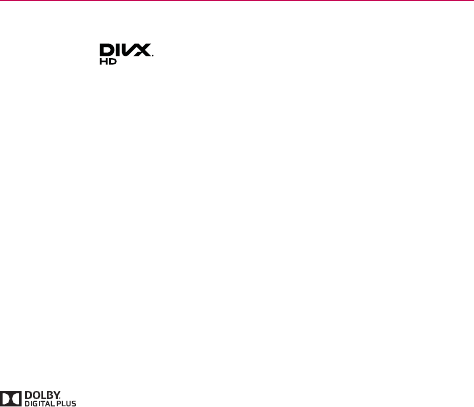
221
Specifications
DivX Mobile
ABOUT DIVX VIDEO: DivX® is a digital video format created by DivX, LLC,
a subsidiary of Rovi Corporation. This is an official DivX Certified® device
that has passed rigorous testing to verify that it plays DivX video. Visit divx.
com for more information and software tools to convert your files into DivX
videos.
ABOUT DIVX VIDEO-ON-DEMAND: This DivX Certified® device must be
registered in order to play purchased DivX Video-on-Demand (VOD) movies.
To obtain your registration code, locate the DivX VOD section in your device
setup menu. Go to vod. divx.com for more information on how to complete
your registration.
DivX Certified® to play DivX® video up to HD 720p, including premium
content. DivX®, DivX Certified® and associated logos are trademarks of
Rovi Corporation or its subsidiaries and are used under license.
Dolby Digital Plus License notice
Manufactured under license from Dolby Laboratories. Dolby
and the double-D symbol are trademarks of Dolby
Laboratories.
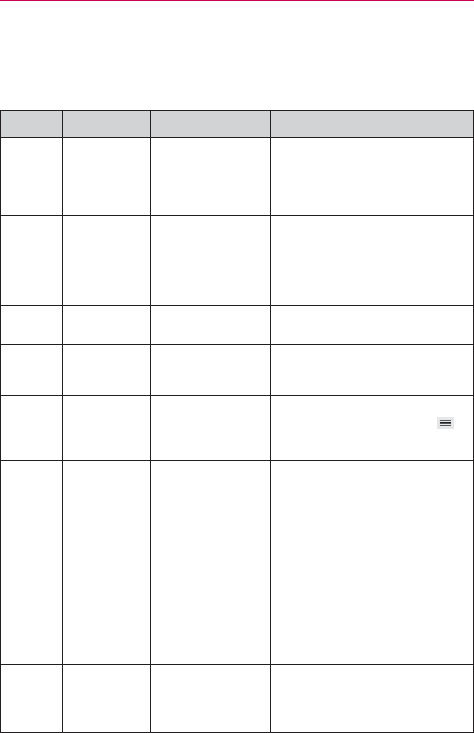
222 FAQ
Please check to see if any problems you have encountered with your
phone are described in this section, before taking the phone in for service
or calling a service representative.
CATEGORY
SUB-CATEGORY QUESTION ANSWER
Bluetooth Bluetooth
Devices
What are the
functions available via
Bluetooth?
Stereo/Mono Headset, Car Kit, and FTP
connections are available. When your
phone connected to another phone via
Bluetooth, you can receive Contacts
data.
Bluetooth Bluetooth
Headset
If my Bluetooth
headset is connected,
can I listen to my
music through my
3.5mm wired
headphones?
When a Bluetooth headset is
connected, all system sounds are
played over the headset. As a result,
you will not be able to listen to music
through your wired headphones.
Data Contacts Backup How can I back up
Contacts?
The Contacts data can be synchronized
between your phone and Gmail™.
Data Synchronization
Is it possible to set up
one-way-sync with
Gmail?
Only two-way synchronization is
available.
Data Synchronization
Is it possible to
synchronize all of the
Email folders?
All of your Email folders are
synchronized. Tap the Menu Key
(in the Front Touch Keys bar), then tap
Folders to view them.
Data Synchronization
Is it possible to
transfer Contacts data
from a feature phone
to an Android™
phone?
Yes, if your contacts can be extracted
into a .CSV file.
How to transfer:
1. Create “.CSV” file with the contacts
on your current phone (you may be
able to use the PC suite software
provided by LGE).
2. Log into Gmail with your PC.
3. Click Contacts.
4. Click Import.
5. Attach the “.CSV” file.
6. Your contacts will then be
synchronized between your Android
phone and Gmail.
Google™
Service Gmail Log-In
Should I have to log
into Gmail whenever I
want to access
Gmail?
Once you log into Gmail, you don’t
need to log into Gmail again.
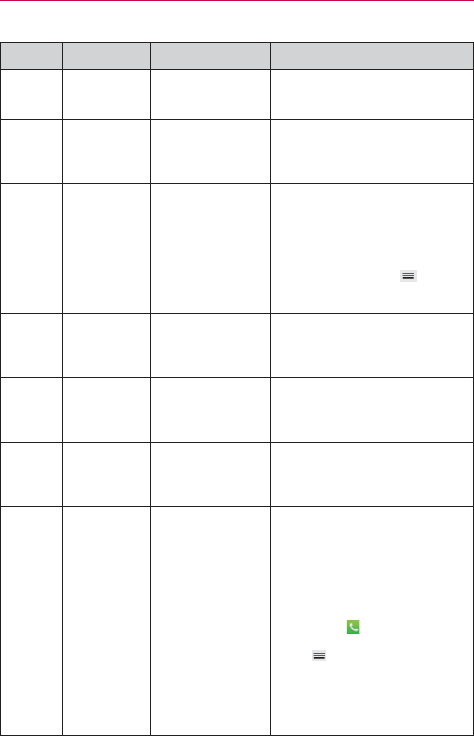
223
FAQ
CATEGORY
SUB-CATEGORY QUESTION ANSWER
Google
Service Google Account Is it possible to filter
emails?
No, email filtering is not supported via
the phone.
Phone
Function YouTube™ Is it possible to play
YouTube videos?
Yes, YouTube videos are supported but
may have to be viewed through the
YouTube application (instead of the
Chrome application).
Phone
Function Email
What happens when I
access another
application while
writing an email?
Your email is automatically saved as a
draft when you access another
application. It is still displayed when
you return to Email, until you close the
Email application. When you open the
Email application again, from your
Inbox, tap the Menu Key (in the
Front Touch Keys bar), then Folders >
Drafts to access it.
Phone
Function Ringtone
Is there a file size
limitation for when I
want to use an .MP3
file as a ringtone?
There is no file size limitation.
Phone
Function Navigation
Is it possible to install
another navigation
application on my
phone?
Any application that is available on Play
Store and is compatible with the
hardware can be installed and used.
Phone
Function Synchronization
Is it possible to
synchronize my
contacts from all of
my email accounts?
Only Gmail and MS Exchange server
(Company Email Server) contacts can
be synchronized.
Phone
Function Wait and Pause
Why don't my phone
numbers with Wait
and Pause work?
If you transferred a contact with the
Wait and Pause functions saved into
the number, you will need to re-save
each number to use these features.
To re-save numbers with Wait and
Pause
1. From the Home screen, tap the
Phone Key in the Quick Keys bar.
2. Dial the number, then tap the Menu
Key (in the Front Touch Keys
bar).
3. Tap Add 2-sec pause or Add wait,
enter the remaining numbers, then
tap Save to Contacts to save the
number for the Contact.

224 FAQ
CATEGORY
SUB-CATEGORY QUESTION ANSWER
Phone
Function Security
What are the phone’s
security functions?
You are able to set the phone to require
the entry of an unlock sequence (face
recognition, pattern, PIN, or password)
before the phone can be accessed or
used.
Phone
Function Unlock Pattern
What should I do if I
forget my Unlock
Pattern?
After attempting the Unlock Pattern 5
times, you can tap the Forgot Pattern?
option and use your Google Account
information or Backup PIN to unlock
your phone.
Phone
Function Unlock Pattern How do I create the
Unlock Pattern?
1. From the Home screen, tap the
Menu Key (in the Front Touch
Keys bar).
2. Tap Lock screen settings.
3. Tap Select screen lock.
4. Tap Pattern. The first time you do
this, a short tutorial about creating an
unlock pattern appears.
5. Set up by drawing your pattern once,
tap Continue, draw it again, then tap
Confirm.
Phone
Function Speed Dial Is Speed Dialing
supported?
Yes. You can set Speed Dials as well as
save a contact directly on your Home
screen.
To set a Speed Dial:
1. Open the Contacts application.
2. Tap the Menu Key (in the Front
Touch Keys bar) > Speed dial.
3. Tap the speed dial location and select
the desired contact.
To set a Direct Dial shortcut to your
Home screen:
1. Touch and hold an empty area on
your Home screen.
2. Tap the Widgets tab > Direct dial.
3. Tap the contact in your Contacts list.
Phone
Function Memory Will I know when my
memory is full? Yes, you will receive a notification.
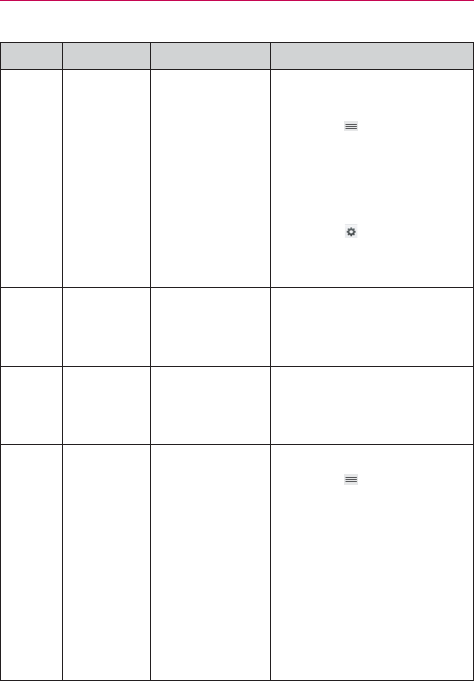
225
FAQ
CATEGORY
SUB-CATEGORY QUESTION ANSWER
Phone
Function
Language
Support
Is it possible to
change the language?
The phone has multi-lingual capabilities.
To change the language:
1. From the Home screen, tap the
Menu Key (in the Front Touch
Keys bar) > Settings.
2. Tap Language & input > Language.
3. Tap the desired language.
NOTE To set multiple languages for
your on-screen keyboard, from the
Language & input screen, tap the
Settings icon (next to LG Keyboard),
tap Input language and type, then
checkmark the languages you want to
be able to type.
Phone
Function
Language
Support
Which languages are
supported when
using Play Store?
The Play Store application supports
English and Spanish. Third party
applications may not support all
languages.
Phone
Function VPN How do I set up a
VPN?
VPN access configuration is different
according to each company. To
configure VPN access from your phone,
you must obtain the details from your
company’s network administrator.
Phone
Function Screen time out
My screen turns off
after only 30 seconds.
How can I change the
amount of time for
the backlight to turn
off?
1. From the Home screen, tap the
Menu Key (in the Front Touch
Keys bar).
2. Tap Settings > Display > Screen
timeout.
3. Tap the preferred screen backlight
timeout time.
NOTE You can also turn on the Smart
screen and Smart video features to
keep the screen from turning off when
the device detects your eyes looking at
the screen. From the Settings menu,
tap Display, then checkmark Smart
screen and/or Smart video.

226 FAQ
CATEGORY
SUB-CATEGORY QUESTION ANSWER
Phone
Function Wi-Fi and 4G
When Wi-Fi and 4G
are both available,
which service will my
phone use?
When using data, your phone may
default to the Wi-Fi connection (if Wi-Fi
connectivity on your phone is set to
On). However, there will be no
notification when your phone switches
from one to the other.
To know which data connection is
being used, use the 4G or Wi-Fi icon
in the Status Bar at the top of your
screen.
Phone
Function Home screen
Is it possible to
remove an application
from the Home
screen?
Yes. Just touch and hold the icon until
the Remove bar appears at the top of
the screen. Then, without lifting your
finger, drag the icon to the Remove
bar, then lift your finger.
Phone
Function Application
I downloaded an
application and it
causes a lot of errors.
How do I remove it?
1. From the Home screen, tap the
Menu Key (in the Front Touch
Keys bar).
2. Tap Settings > Application manager.
3. Tap the application > Uninstall.
Phone
Function Ringtones Can I use music files
for my ringtones?
Yes. After saving a music file as a
ringtone, you can use it anywhere you
can set ringtones as an alert.
Touch and hold a song in a library list. In
the Context menu that opens, tap Set
music as.
Phone
Function Alarm
Will my alarm be
audible or will it go off
if the phone is turned
off?
No, this is not supported.
Phone
Function Alarm
If my Ringer Volume
is set to Off or
Vibrate, will I hear my
alarm?
Your alarm is programmed to be audible
even in these scenarios.
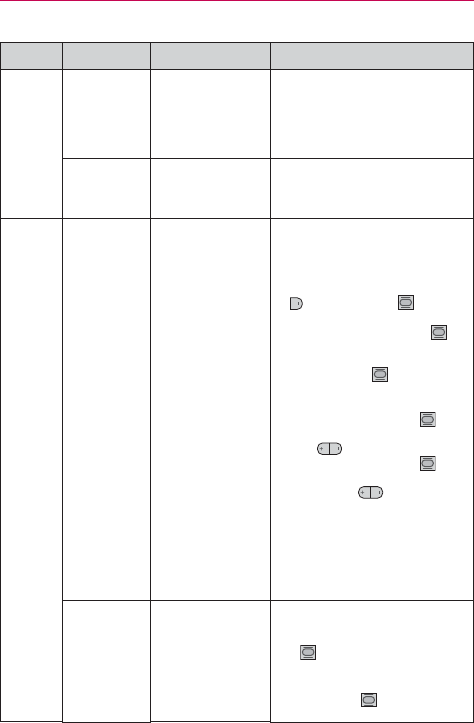
227
FAQ
CATEGORY
SUB-CATEGORY QUESTION ANSWER
Phone
Spec
Battery Time
What is the maximum
amount of time my
phone’s battery will
last before I need to
recharge it?
Talk time: Approx. 1150 mins
Standby: Approx. 11.5 days
Band
Which wireless bands
are supported by the
phone?
Your phone is able to operate on the
800MHz, 1900MHz.
Recovery
Solution
Factory Reset
How can I perform a
factory reset if I can’t
access the phone’s
Settings menu?
How to perform a factory reset:
1. Turn the phone off.
2. Press and hold the following keys at
the same time: Volume Down Key
+ Power/Lock Key on the
back of the phone.
3. Release the Power/Lock Key
only when the LG logo is displayed,
then immediately press and hold the
Power/Lock Key again.
4. Release all keys when the Factory
hard reset screen is displayed.
5. Press the Power/Lock Key to
continue or either of the Volume
Keys to cancel.
6. Press the Power/Lock Key once
more to confirm or either of the
Volume Keys to cancel.
Attention:
If a factory reset is performed, all
installed applications and user data will
be erased. Please remember to back
up any important data before
performing a factory reset.
Power Reset Phone is locked-up
and does not function
In the case of a malfunction or lock up
error, press and hold the Power/Lock
Key for 8 seconds to reset the
phone.
To power off, press and hold the
Power/Lock Key 2 seconds longer.

228 LIMITED WARRANTY STATEMENT
1. WHAT THIS WARRANTY COVERS:
LG offers you a limited warranty that the enclosed subscriber unit and its
enclosed accessories will be free from defects in material and
workmanship, according to the following terms and conditions:
(1) The limited warranty for the product extends for TWELVE (12) MONTHS
beginning on the date of purchase of the product with valid proof of
purchase, or absent valid proof of purchase, FIFTEEN (15) MONTHS
from date of manufacture as determined by the unit’s manufacture date
code.
(2) The limited warranty extends only to the original purchaser of the
product and is not assignable or transferable to any subsequent
purchaser/end user.
(3) This warranty is good only to the original purchaser of the product during
the warranty period as long as it is in the U.S., including Alaska, Hawaii,
U.S. Territories and Canada.
(4) The external housing and cosmetic parts shall be free of defects at the
time of shipment and, therefore, shall not be covered under these
limited warranty terms.
(5) Upon request from LG, the consumer must provide information to
reasonably prove the date of purchase.
(6) The customer shall bear the cost of shipping the product to the
Customer Service Department of LG. LG shall bear the cost of shipping
the product back to the consumer after the completion of service under
this limited warranty.
2. WHAT THIS WARRANTY DOES NOT COVER:
(1) Defects or damages resulting from use of the product in other than its
normal and customary manner.
(2) Defects or damages from abnormal use, abnormal conditions, improper
storage, exposure to moisture or dampness, unauthorized modifications,
unauthorized connections, unauthorized repair, misuse, neglect, abuse,
accident, alteration, improper installation, or other acts which are not the
fault of LG, including damage caused by shipping, blown fuses, spills of
food or liquid.
(3) Breakage or damage to antennas unless caused directly by defects in
material or workmanship.
(4) That the Customer Service Department at LG was not notified by
consumer of the alleged defect or malfunction of the product during the
applicable limited warranty period.

229
LIMITED WARRANTY STATEMENT
(5) Products which have had the serial number removed or made illegible.
(6) This limited warranty is in lieu of all other warranties, express or implied
either in fact or by operations of law, statutory or otherwise, including,
but not limited to any implied warranty of marketability or fitness for a
particular use.
(7) Damage resulting from use of non LG approved accessories.
(8) All plastic surfaces and all other externally exposed parts that are
scratched or damaged due to normal customer use.
(9) Products operated outside published maximum ratings.
(10) Products used or obtained in a rental program.
(11) Consumables (such as fuses).
3. WHAT LG WILL DO:
LG will, at its sole option, either repair, replace or refund the purchase price
of any unit that does not conform to this limited warranty. LG may choose
at its option to use functionally equivalent re-conditioned, refurbished or
new units or parts or any units. In addition, LG will not re-install or back-up
any data, applications or software that you have added to your phone. It is
therefore recommended that you back-up any such data or information
prior to sending the unit to LG to avoid the permanent loss of such
information.
4. STATE LAW RIGHTS:
No other express warranty is applicable to this product. THE DURATION OF
ANY IMPLIED WARRANTIES, INCLUDING THE IMPLIED WARRANTY OF
MARKETABILITY, IS LIMITED TO THE DURATION OF THE EXPRESS
WARRANTY HEREIN. LG SHALL NOT BE LIABLE FOR THE LOSS OF THE
USE OF THE PRODUCT, INCONVENIENCE, LOSS OR ANY OTHER
DAMAGES, DIRECT OR CONSEQUENTIAL, ARISING OUT OF THE USE
OF, OR INABILITY TO USE, THIS PRODUCT OR FOR ANY BREACH OF
ANY EXPRESS OR IMPLIED WARRANTY, INCLUDING THE IMPLIED
WARRANTY OF MARKETABILITY APPLICABLE TO THIS PRODUCT.

230 LIMITED WARRANTY STATEMENT
Some states do not allow the exclusive limitation of incidental or
consequential damages or limitations on how long an implied warranty
lasts; so these limitations or exclusions may not apply to you. This warranty
gives you specific legal rights and you may also have other rights which
vary from state to state.
5. HOW TO GET WARRANTY SERVICE:
If you experience any problems with either the Bluetooth headset or the
mobile handset, in each case as may be covered by this limited warranty,
you need only return the affected device. For example, if a problem exists
with the Bluetooth headset, please DO NOT return your mobile handset
with the headset. Likewise, if a problem exists with the mobile handset,
please DO NOT return the Bluetooth Headset with the handset.
To obtain warranty service, please call or fax to the following telephone
numbers from anywhere in the continental United States:
Tel. 1-800-793-8896 or Fax. 1-800-448-4026
Or visit http://us.lgservice.com. Correspondence may also be mailed to:
LG Electronics Service- Mobile Handsets, P.O. Box 240007, Huntsville, AL
35824
DO NOT RETURN YOUR PRODUCT TO THE ABOVE ADDRESS.
Please call or write for the location of the LG authorized service center
nearest you and for the procedures for obtaining warranty claims.

231
LIMITED WARRANTY STATEMENT
7.11 Warranty Laws
The following laws govern warranties that arise in retail sales of
consumer goods:
ţThe California Song-Beverly Consumer Warranty Act [CC §§1790
et seq],
ţThe California Uniform Commercial Code, Division Two [Com C
§§2101 et seq], and
ţThe federal Magnuson-Moss Warranty Federal Trade Commission
Improvement Act [15 USC §§2301 et seq; 16 CFR Parts 701– 703].
A typical Magnuson-Moss Act warranty is a written promise that
the product is free of defects or a written promise to refund, repair,
or replace defective goods. [See 15 USC §2301(6).] Remedies
include damages for failing to honor a written warranty or service
contract or for violating disclosure provisions. [See 15 USC
§2310(d).] Except for some labeling and disclosure requirements,
the federal Act does not preempt state law. [See 15 USC §2311.]
The Consumer Warranty Act does not affect the rights and obligations
of parties under the state Uniform Commercial Code, except the
provisions of the Act prevail over provisions of the Commercial Code
when they conflict. [CC §1790.3.]
For purposes of small claims actions, this course will focus on rights
and duties under the state laws.

232 Index
Numbers
10 Driver Safety Tips 218
A
Adding an event to your
calendar 148
Adding Contacts 82
Alarm/Clock 152
Answering or Rejecting Calls
60
Applications: How to View,
Open, and Switch 28
Avoid potential hearing loss.
202
B
Browse with tabs 71
C
Calculator 150
Calendar 146
Calling Your Contacts 64
Calls 57
Camera 108
Changing Messaging
Settings 89
Charging the Phone 9
Chrome 69
Chrome Settings 74
Communicating With Your
Contacts 85
Communication 79
Composing and Sending a
Message 103
Connecting to Mobile
Networks 50
Connecting to Networks and
Devices 50
Connecting to Wi-Fi
Networks 51
Consumer Information
About Radio Frequency
Emissions 194
Consumer Information on
SAR 198
Contacts 79
Customizing the Home
Screen 48
D
Download files 73
Downloading and Installing
Applications 129
Driving 218
E
Email 93
Entertainment 108
F
FAQ 222
Favorites Contacts 83
FCC Hearing-Aid
Compatibility (HAC)
Regulations for Wireless
Devices 200
FDA Consumer Update 210
File Manager 162
G
Gallery 120
Getting to Know the Home
Screen 17
Gmail 99
Guest mode 46
H
Hangouts 106
Hardware key control mode
27
Help 8
I
Important Customer
Information 1
L
Languages 27
LIMITED WARRANTY
STATEMENT 228
Listening to Your Voicemail
67
Locking the Screen 43
M
Managing Multiple Calls 66
Managing Notifications 36
Maps 155
Messaging 86
Mini canvas view 19
Music 130
N
Non-Removable Battery 8

233
Index
O
Opening Email and the
Accounts Screen 93
Opening YouTube and
Watching Videos 135
Optimizing Battery Life 10
Optional: Remove the SIM
Card 8
Options During a Call 65
P
Phone Overview 5
Phone’s Status Icons 15
Placing and Ending Calls 57
Playing Music 131
Play Store 128
POLARIS Office 5 161
Q
QSlide 141
QSlide apps on the
Notifications panel 39
QSlide icons on the
Notifications panel 141
QuickMemo 139
QuickRemote 144
QuickTranslator 143
R
Reading Your Messages 94,
102
Replying to or Forwarding a
Message 104
S
Safety 191
Safety Information 206
Searching Your Phone and
the Web 40
Setting and Activating
Alarms 152
Settings 165
Setting the Timer 154
Setting the World Clock 154
Setting up your Google
Account 14
Specifications 221
T
Table of Contents 2
Tasks 164
Text Input Methods 24
The Basics 5
TIA Safety Information 203
Tools 136
Touchscreen 21
Transferring Music Files to
Your Phone 130
Turning the Phone On and
Off 12
U
USB connection 53
Using bookmarks 73
Using Magic Remote feature
146
Using SmartShare 54
Using the Audio Zoom 118
Using the Dual recording
mode 118
Using the Stopwatch 155
Using the Tracking zoom
mode 119
V
Video Camera 115
Video Editor 126
Video Player 125
Viewing Event Details 149
Viewing Your Calendar and
Events 146
Voice Mail 98
Voice Mate 158
Voice Recorder 159
VuTalk 136
W
Weather 157
Web 69
WIRELESS & NETWORKS
165
Working with Menus 35
Working with photos 121
Working with Playlists 134
Working with tabs 72
Working with the Recent 62
Working with Videos 123
Writing Your Messages 95
Y
YouTube™ 135
